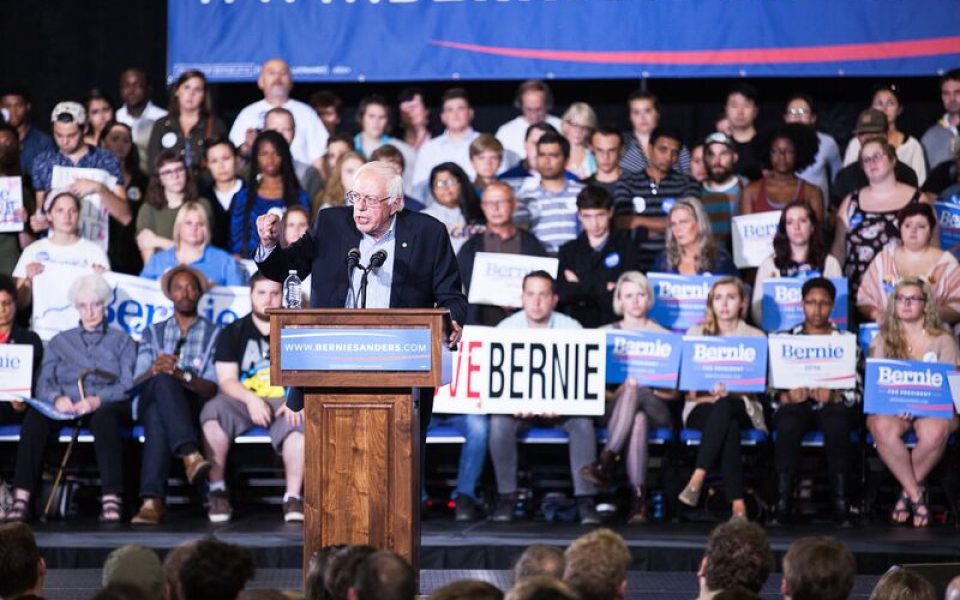Photo by Caleb Smallwood
by Jordan Green
Both inside the special events center and outside in the overflow hall, people were taking a good, hard look at the faces in the crowd at Bernie Sanders’ Sunday evening rally.
Predominantly white? No doubt. Diverse? Certainly, if you considered the heavy showing of college students to complement the cohort of seniors and aging boomers. In a state where blacks make up the committed base of the Democratic Party, African-American representation at the rally fell significantly short of their portion of the party rank-and-file. Based on a scan of the crowd in Greensboro, it appeared there were more Asian than black attendees. Regardless of race, many of the people at the rally were faculty and grad students who walked from UNCG’s park-and-ride lot, so the academic skew of the crowd makes it difficult to predict how Sanders’ plainspoken New England economic populism will translate with North Carolina’s greater Democratic electorate.
The campaign is conscientious about the optics of diversity, with two black women, his press secretary Symone Sanders and Communications Workers of America organizer Angie Wells, warming up the crowd for the candidate, along with Nida Allam, a student at NC State University who described herself as a Muslim American.
The Sanders campaign is a genuine phenomenon, no doubt, but what part of the presidential campaign in this cycle isn’t off script? The energized crowd in the special events center was populated by stalwart progressive activists, but their ranks were replenished by new, previously apolitical converts. Christopher Gagnon of Charlotte posted on Instagram: “My first political rally was a great one.” Winston-Salem musician and Phuzz Phest organizer Philip Pledger tweeted a selfie with his crew at the rally.
Sanders has Hillary Clinton running scared in the early primary states of Iowa and New Hampshire, and now she has to be worried too about the South, which until recently was considered her firewall. The atmosphere feels like the Ralph Nader campaign in 2000 or the Deaniacs in 2004, although the narrative likely preferred by Sanders supporters is a comparison with Barack Obama in 2008.
Having covered four presidential campaigns — and countless local and state races — I can appreciate why Sanders’ candidacy resonates so strongly. Other candidates, including both Clintons, elevate political speeches to a spurious art, striking a populist note here, getting off a zinger against an opponent there. But when it comes to the payoff, instead they spin off to an arcane policy point, an anecdote about a challenging upbringing or a platitude about American resiliency. The reporter taking notes in the audience is lucky to salvage one out of five quotes.
You might expect that a candidate who reels off one policy prescription after another would put people to sleep. But Sanders’ fiery delivery, which builds to a roar with each point, does exactly the opposite. And, fortunately for the scrambling reporter, each pithy policy line is followed by a sustained round of applause, providing ample time to catch up.
“We have got to end this disgrace and embarrassment,” Sanders said. “Instead of having more people in jail than any other country, how about having the best educated population in the world?”
The content and the surface appearance of the statement are one and the same; there’s no spring-loaded IED embedded in the rhetoric.
That one was followed by, “Wages in America are just too damn low.”
The only place in Sanders’ standard speech where he slowed down and started qualifying himself is the piece added to address racial injustice. After mentioning “unarmed African Americans who died at the hands of the police or in police custody” — and naming a handful of them — he went on say that “the vast majority of police officers are honest, work hard and do a good job.” He finally concluded, “Any officer that breaks the law must be held accountable.”
In her introductory remarks, Symone Sanders seemed to be compensating for her boss, making a full-throated both-and argument.
“Economic inequality and racial inequality are parallel issues that must be addressed simultaneously,” she said.
In this very strange election season, it appears that an avowed socialist might just lock down the Democratic nomination, while a self-aggrandizing, xenophobic second coming of the Fuhrer seems to be cruising towards the top of the Republican ticket. Past can be prologue, and it’s worth noting that the socialists were at the height of their influence in Germany in the polarized atmosphere that gave rise to fascism. And in Spain around the same time, a coalition of anarchists, socialists and republicans lost a civil war to the fascists. It’s at least plausible, if not certain, that in the current political moment we’re headed for trouble.
Considering that our nation has encountered unforeseen challenges already, I may as well throw out the nightmare scenario. Imagine a Sanders-Trump contest in November 2016. White conservatives scared half to death by Sanders’ economic policies turn out in droves to vote for Trump in politically divided states like North Carolina, Pennsylvania and Ohio, while turnout is depressed among black Democrats who feel like Sanders doesn’t get their issues.
Do political progressives have a backup plan?
Join the First Amendment Society, a membership that goes directly to funding TCB‘s newsroom.
We believe that reporting can save the world.
The TCB First Amendment Society recognizes the vital role of a free, unfettered press with a bundling of local experiences designed to build community, and unique engagements with our newsroom that will help you understand, and shape, local journalism’s critical role in uplifting the people in our cities.
All revenue goes directly into the newsroom as reporters’ salaries and freelance commissions.


I’m sure there were many UNCG faculty, staff, and students in attendance -maybe all around you, Jordan – but I doubt they would be predominant in a crowd of over 9,000.
Gotta throw in the Hitler reference. Nice promo piece for Bernie/hit piece on Trump.